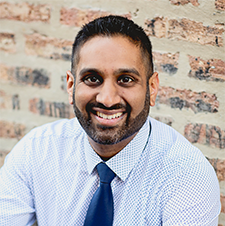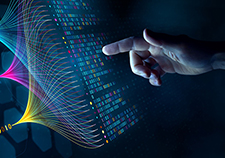Office of Research & Development |
 |


A new study called VA STARPORT is examining an innovative treatment approach for men whose prostate cancer has spread to distant areas, despite surgery or radiation. (Photo for illustrative purposes only. ©iStock/Mark Kostich)
July 6, 2021
By Tamar Nordenberg
For VA Research Communications
Prostate cancer has historically been considered incurable once it has spread to parts of the body distant from the prostate gland itself.
Now, a VA study is examining an innovative treatment approach for men whose prostate cancer has spread to a limited number of distant areas despite initial treatment with surgery or radiation.
“Improved treatments are needed for these men whose prostate cancer has spread and who are left without a lifesaving option,” says Dr. Abhishek Solanki. “Promising evidence suggests that men with limited areas of spread may benefit from adding radiation or surgery that targets metastatic lesions to today’s standard treatment with hormones.”

Dr. Abhishek Solanki, a radiation oncologist and researcher at the Hines VA in Chicago, is leading the VA STARPORT trial.
Solanki is a radiation oncologist and researcher with the Hines VA hospital and Loyola University Medical Center in Chicago. He is the lead investigator of a multisite clinical trial funded with $8.6 million through VA’s Cooperative Studies Program. The trial is known by the acronym VA STARPORT. It stands for STAndard Systemic TheRapy With or Without PET-directed Local Therapy for OligoRecurrenT Prostate Cancer.
Solanki summarizes the goal of the trial: “VA STARPORT is designed to provide more definitive evidence of whether local therapy along with systemic treatments will lead to better outcomes for some Veterans with limited spread of their prostate cancer.”
Prostate cancer is the most commonly diagnosed cancer among Veterans in VA. It accounts for nearly a third of cancer diagnoses. Prostate cancer is often found early and cured with treatments such as surgery or radiation. But some patients’ cancer spreads and becomes life-threatening.
“With this technology, we will be able to identify many patients who have metastatic disease that was previously invisible.”
Cancer that has spread, or metastasized, is typically treated with “standard systemic therapy” (SST) that affects the entire body to slow disease progression. The cornerstone of this approach is hormone therapy to suppress testosterone.
VA STARPORT is based on a growing scientific understanding that prostate cancer can spread beyond the prostate itself yet not fan out uncontrollably through the body. By targeting defined areas of metastasis, aggressive local therapy—surgery or radiation—might be capable of diminishing further spread in “oligometastatic,” or “oligorecurrent,” cancer. Such therapy might even help eradicate the cancer altogether in some patients, Solanki says.
The prefix “oligo,” from Greek, means “a few.” The term “oligorecurrent,” as defined in this study, refers to cancer that has spread to no more than five areas.

VA researchers using AI to decide best treatment for rectal cancer

VA center training the next generation of researchers in blood clots and inflammation

AI to Maximize Treatment for Veterans with Head and Neck Cancer

Veterans help find new cancer treatments
To pinpoint the metastatic lesions’ locations and target these areas for treatment as precisely as possible, researchers will use sophisticated positron emission tomography (PET) imaging technology approved by the U.S. Food and Drug Administration in recent years.
For example, one PET imaging technology, expected to become widespread within the VA health care system this year, is called “prostate-specific membrane antigen” PET. It is significantly more accurate than prior imaging options.
“With this technology, we will be able to identify many patients who have metastatic disease that was previously invisible,” explains Dr. Nicholas Nickols, a radiation oncologist specializing in prostate cancer care and research at the VA Los Angeles Health Care System. He is the local site investigator for VA STARPORT in Los Angeles.
Along with these types of groundbreaking advances in imaging and the increased understanding of oligometastasis has also come improved precision in radiotherapy. Clinicians are now able to safely deliver targeted radiation treatment to virtually anywhere within the body, explains Nickols.
He says this trifecta of advances makes it possible to safely identify and control a site of metastasis. Will treating all visible sites of disease matter in the long run for Veterans with metastatic prostate cancer? “We don’t know yet,” Nickols acknowledges. “We need clinical trials like VA STARPORT to answer this critical question.”
VA STARPORT will randomly assign Veteran volunteers with oligorecurrent prostate cancer to either standard systemic therapy alone—with decisions made by each Veteran and his doctor about the exact type—or PET-directed local therapy (surgery or radiation) in addition to SST.
The study begins to enroll Veteran participants in July and is expected to include just over 460 men at 16 VA sites.
Men who take part will be followed with medical scans and bloodwork every three months for the duration of the five-year study, expected to wrap up in mid-2026. Researchers will pay attention to cancer-related indicators such as PSA values and disease changes that appear on images. They will look at any differences in how cancer progresses, survival, and quality of life, in addition to any complications arising from the treatments. And participants’ tumors will be tested using “somatic tumor sequencing” (which is available to any VA patient with metastatic prostate cancer), in hopes of zeroing in on any genetic mutations that could help predict which patients are most likely to benefit from PET-directed local therapy.
The rigorously designed STARPORT study “has an outstanding leader in Abhi Solanki,” says Nickols. Solanki himself, a physician-researcher with expertise in radiation oncology and advanced study design, emphasizes the value of the infrastructure he was able to leverage within the VA research enterprise. He cites the Hines Cooperative Studies Program Coordinating Center, with its expertise in administering challenging, multicenter clinical trials; VA experts in topics such as oligometastasis and advanced radiation therapy; and the Centers of Excellence formed through a Prostate Cancer Foundation-VA partnership.
“VA was the ideal system for conducting this study because of advantages such as access to cutting-edge PET imaging and other technologies and the ability to follow up with patients long term,” he says. “Mostly, I am very thankful for the huge team effort with experts from across the country, and especially for our Veterans, who are altruistic and very excited about participating in clinical trials.”
The results of STARPORT could impact care quickly, says Nickols. As translational science co-chair for the study, he will help ensure that any benefits are applied to patient care as quickly as possible. “If the research shows a benefit from local therapy added to SST,” Solanki concurs, “changes could be implemented almost immediately—across the VA system as well as more broadly in civilian contexts.”
Click here to learn more about the study.
VA Research Currents archives || Sign up for VA Research updates